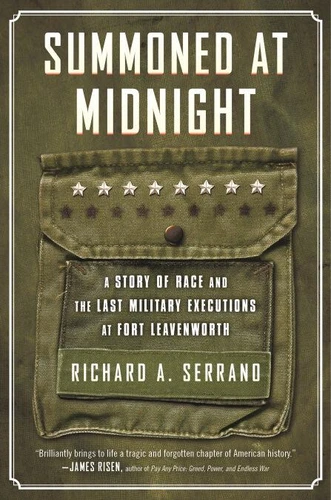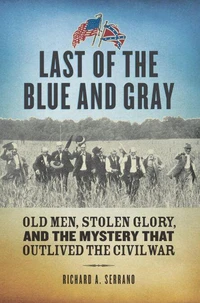Summoned at Midnight. A Story of Race and the Last Military Executions at Fort Leavenworth
Par :Formats :
Disponible dans votre compte client Decitre ou Furet du Nord dès validation de votre commande. Le format ePub protégé est :
- Compatible avec une lecture sur My Vivlio (smartphone, tablette, ordinateur)
- Compatible avec une lecture sur liseuses Vivlio
- Pour les liseuses autres que Vivlio, vous devez utiliser le logiciel Adobe Digital Edition. Non compatible avec la lecture sur les liseuses Kindle, Remarkable et Sony
- Non compatible avec un achat hors France métropolitaine
 , qui est-ce ?
, qui est-ce ?Notre partenaire de plateforme de lecture numérique où vous retrouverez l'ensemble de vos ebooks gratuitement
Pour en savoir plus sur nos ebooks, consultez notre aide en ligne ici
- Nombre de pages256
- FormatePub
- ISBN978-0-8070-6103-9
- EAN9780807061039
- Date de parution05/02/2019
- Protection num.Adobe DRM
- Taille6 Mo
- Infos supplémentairesepub
- ÉditeurBeacon Press
Résumé
Uncovers the hidden world of the military legal system and the intimate history of racism that pervaded the armed forces long after integration. Richard A. Serrano reveals how racial discrimination in the US military criminal justice system determined whose lives mattered and deserved a second chance and whose did not. Between 1955 and 1961, a group of white and black condemned soldiers lived together on death row at Fort Leavenworth military prison.
Although convicted of equally heinous crimes, all the white soldiers were eventually paroled and returned to their families, spared by high-ranking army officers, the military courts, sympathetic doctors, highly trained attorneys, the White House staff, or President Eisenhower himself. During the same 6-year period, only black soldiers were hanged. Some were cognitively challenged, others addicted to substances or mentally unbalanced-the same mitigating circumstances that had won white soldiers their death row reprieves.
These men lacked the benefits of political connections, expert lawyers, or public support; only their mothers begged fruitlessly for their lives to be spared. By 1960, John Bennett was the youngest black inmate at Fort Leavenworth. His lost battle for clemency was fought between 2 vastly different presidential administrations-Eisenhower's and Kennedy's-as the civil rights movement was gaining steam.
Drawing on interviews, trial transcripts, and rarely published archival material, Serrano brings to life the characters in this lost history: from desperate mothers and disheartened appeals lawyers, to the prison doctors, psychiatrists, and chaplains. He shines a light on the scandalous legal maneuvering that reached the doors of the White House and the disparity in capital punishment that was cut so strictly along racial lines.
Although convicted of equally heinous crimes, all the white soldiers were eventually paroled and returned to their families, spared by high-ranking army officers, the military courts, sympathetic doctors, highly trained attorneys, the White House staff, or President Eisenhower himself. During the same 6-year period, only black soldiers were hanged. Some were cognitively challenged, others addicted to substances or mentally unbalanced-the same mitigating circumstances that had won white soldiers their death row reprieves.
These men lacked the benefits of political connections, expert lawyers, or public support; only their mothers begged fruitlessly for their lives to be spared. By 1960, John Bennett was the youngest black inmate at Fort Leavenworth. His lost battle for clemency was fought between 2 vastly different presidential administrations-Eisenhower's and Kennedy's-as the civil rights movement was gaining steam.
Drawing on interviews, trial transcripts, and rarely published archival material, Serrano brings to life the characters in this lost history: from desperate mothers and disheartened appeals lawyers, to the prison doctors, psychiatrists, and chaplains. He shines a light on the scandalous legal maneuvering that reached the doors of the White House and the disparity in capital punishment that was cut so strictly along racial lines.
Uncovers the hidden world of the military legal system and the intimate history of racism that pervaded the armed forces long after integration. Richard A. Serrano reveals how racial discrimination in the US military criminal justice system determined whose lives mattered and deserved a second chance and whose did not. Between 1955 and 1961, a group of white and black condemned soldiers lived together on death row at Fort Leavenworth military prison.
Although convicted of equally heinous crimes, all the white soldiers were eventually paroled and returned to their families, spared by high-ranking army officers, the military courts, sympathetic doctors, highly trained attorneys, the White House staff, or President Eisenhower himself. During the same 6-year period, only black soldiers were hanged. Some were cognitively challenged, others addicted to substances or mentally unbalanced-the same mitigating circumstances that had won white soldiers their death row reprieves.
These men lacked the benefits of political connections, expert lawyers, or public support; only their mothers begged fruitlessly for their lives to be spared. By 1960, John Bennett was the youngest black inmate at Fort Leavenworth. His lost battle for clemency was fought between 2 vastly different presidential administrations-Eisenhower's and Kennedy's-as the civil rights movement was gaining steam.
Drawing on interviews, trial transcripts, and rarely published archival material, Serrano brings to life the characters in this lost history: from desperate mothers and disheartened appeals lawyers, to the prison doctors, psychiatrists, and chaplains. He shines a light on the scandalous legal maneuvering that reached the doors of the White House and the disparity in capital punishment that was cut so strictly along racial lines.
Although convicted of equally heinous crimes, all the white soldiers were eventually paroled and returned to their families, spared by high-ranking army officers, the military courts, sympathetic doctors, highly trained attorneys, the White House staff, or President Eisenhower himself. During the same 6-year period, only black soldiers were hanged. Some were cognitively challenged, others addicted to substances or mentally unbalanced-the same mitigating circumstances that had won white soldiers their death row reprieves.
These men lacked the benefits of political connections, expert lawyers, or public support; only their mothers begged fruitlessly for their lives to be spared. By 1960, John Bennett was the youngest black inmate at Fort Leavenworth. His lost battle for clemency was fought between 2 vastly different presidential administrations-Eisenhower's and Kennedy's-as the civil rights movement was gaining steam.
Drawing on interviews, trial transcripts, and rarely published archival material, Serrano brings to life the characters in this lost history: from desperate mothers and disheartened appeals lawyers, to the prison doctors, psychiatrists, and chaplains. He shines a light on the scandalous legal maneuvering that reached the doors of the White House and the disparity in capital punishment that was cut so strictly along racial lines.





